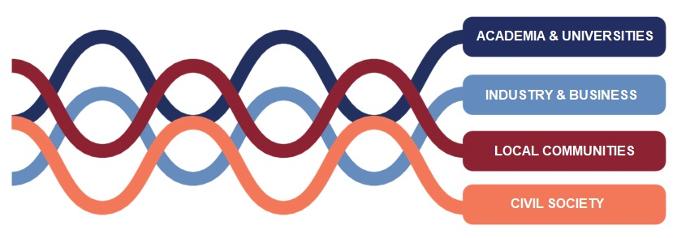The Quadruple Helix Model in Marmara Incubation System: A Comprehensive Approach to Assessing Innovation
The Quadruple Helix model of Marmara Incubation System, a groundbreaking approach to innovation, brings together the key players from academia, industry, civil society, and local communities to foster collaboration and drive economic growth. This model transcends traditional boundaries and encourages a holistic perspective that is crucial for the development of innovative projects.

Introduction:
The Quadruple Helix model of Marmara Incubation System, a groundbreaking approach to innovation, brings together the key players from academia, industry, civil society, and local communities to foster collaboration and drive economic growth. This model transcends traditional boundaries and encourages a holistic perspective that is crucial for the development of innovative projects. The Marmara Project Evaluation Board (PEB) has adopted this model to create a comprehensive and inclusive system for evaluating and supporting entrepreneurial endeavors within the Marmara Open Innovation Community. In this blog post, we will delve into the intricacies of the Quadruple Helix Model and explore how it empowers the Marmara Project Evaluation Board to effectively assess innovation.
The Quadruple Helix Model: Four Pillars of Innovation
The Quadruple Helix Model comprises four essential components that work in synergy to foster innovation and sustainable development:
Academia: Researchers and academics bring scientific expertise and cutting-edge knowledge, contributing to the development of innovative solutions through research and development.
Industry and Business: Businesspeople and entrepreneurs provide practical experience, market insights, and resources necessary to transform innovative ideas into viable products and services.
Civil Society: Representatives from civil society organizations contribute their understanding of social challenges and help ensure that projects address real-world problems and improve the quality of life.
Local Communities: Local community representatives provide valuable input on the specific needs and expectations of the area where the project will be realized, ensuring a tailored approach that takes into account the unique characteristics of the target community.
Marmara's Project Evaluation Board: Leveraging the Quadruple Helix Model
The Marmara Project Evaluation Board (PEB) has integrated the Quadruple Helix Model into its assessment process to ensure a diverse range of perspectives are considered during project evaluation. The committee consists of representatives from academia, industry & Business, civil society, and local communities, who collaboratively assess the potential and viability of projects submitted by entrepreneurs.
The evaluation process begins with a preliminary assessment, in which at least one representative from each of the four helix categories examines the project based on its specific domain. Following this, the assessment reports are presented to the full PEB board, which consists of a minimum of 12 members, ensuring equal representation from each category as much as possible. The board then votes on the projects, and those that receive approval enter the Marmara Open Incubation System.
Benefits of the Quadruple Helix Model in Marmara's Project Evaluation Board
The adoption of the Quadruple Helix Model in the Marmara Project Evaluation Board offers several benefits:
Comprehensive Assessment: By including experts from diverse backgrounds, the evaluation process ensures a thorough examination of projects from multiple angles, increasing the likelihood of identifying truly innovative ideas with high potential.
Inclusiveness: The Quadruple Helix Model encourages collaboration among stakeholders, promoting inclusiveness and fostering a sense of shared ownership in the innovation process.
Sustainable Development: The diverse perspectives brought together by the Quadruple Helix Model enable the development of projects that are economically viable, socially responsible, and environmentally friendly, contributing to sustainable growth.
Conclusion:
The Quadruple Helix Model employed by Marmara's Project Evaluation Board offers a comprehensive and inclusive approach to assessing innovation. By bringing together diverse stakeholders from academia, industry, civil society, and local communities, the committee ensures a holistic evaluation process that identifies and supports groundbreaking projects with the potential to drive sustainable development and economic growth. This innovative approach positions Marmara as a leading force in fostering entrepreneurship and collaboration within the global innovation landscape.